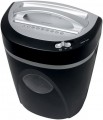Shredding Items
Types of media and materials that the shredder can utilize. Note that, by definition, all such devices are capable of working with paper documents, so paper is not mentioned in this paragraph (some models are generally
only compatible with paper and do not allow using other materials). However, shredders with the ability to utilize various additional items are more common — mainly
staplers,
paper clips,
credit cards and/or
CDs/DVDs. Here are the features of each of these options:
— Staples. An auxiliary function designed to ensure that stapled materials do not have to be separated before being loaded into the shredder. Allows you to significantly save time when utilizing of such materials, especially in large volumes; also provides a correct operation guarantee in case of accidental contact with the staples.
— Paper clips. Paper clips are removed much easier than staplers and there is no problem with them even with a large amount of documents. Therefore, this function is rather an insurance against getting such a clip into the device along with the document.
— Credit cards. The ability to recycle various plastic cards with magnetic media — credit cards, passes, etc. This feature at least prevents the illegal use of such cards, and with a high security level it allows you to
...keep the fact of the existence of a card in secret. Actually, the security level for such utilization is indicated in the generally accepted standard DIN 66399, as like as for paper, and there are seven of them:
- 1 — the card remains intact, its surface is mechanically damaged;
- 2 — the card is cut into pieces with an area of less than 2000 mm²;
- 3 — size of pieces less than 320 mm²;
- 4 — less than 160 mm²;
- 5 — less than 30 mm²;
- 6 — less than 10 mm²;
- 7 — less than 2.5 mm².
— CDs/DVDs. Ability to utilize optical discs, which can also store confidential information. For such media, DIN 66399 also provides 7 security levels:
- 1 — the disk is cut into pieces with an area of less than 2000 mm²;
- 2 — less than 800 mm²;
- 3 — less than 160 mm²
- 4 — less than 30 mm²;
- 5 — less than 10 mm²;
- 6 — less than 5 mm²;
- 7 — less than 0.2 mm².
Break time
The minimum break time required by the shredder after a full cycle of work (see above).
A break is required so that the motor and mechanisms of the device can cool down after the intense loads that they are subjected to during operation. Moreover, if the operating time was less than a full cycle, then the break can also be made shorter; however, if the device has worked for more than half of the cycle, for a full assurance it is still worth to take a break for all the time intended for it. Some models may provide other recommendations in this regard — they should be specified in user's manual.
Motor power
The power of the motor that drives the exterminator knives.
Engine specs are selected by manufacturers in such a way that the unit is guaranteed to be able to complete the tasks it's intended to. Therefore, while choosing the shredder this parameter has minor importance, the main attention should be paid to more lifelike specs — the sheets-per-load capacity, the speed of destruction, etc. However, devices of a similar degree of secrecy and price category may differ in power. In such cases, the difference is that a more powerful motor is capable of providing a thicker load stack, a faster shred rate, and/or a longer duty cycle (see above). The cons of these benefits are an increase in cost rate and energy consumption.
Regarding energy consumption, it is also worth noting that the motor power usually more or less corresponds to the total power consumption of the shredder. This data can be useful for some specific calculations — for example, calculating the total power of the load connected to an uninterruptible power supply.

